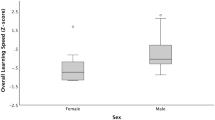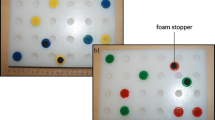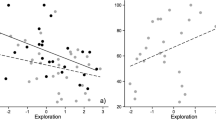Abstract
The domestication process leads to a change in behavioural traits, usually towards individuals that are less attentive to changes in their environment and less aggressive. Empirical evidence for a difference in cognitive performance, however, is scarce. Recently, a functional linkage between an individual’s behaviour and cognitive performance has been proposed in the framework of animal personalities via a shared risk–reward trade-off. Following this assumption, bolder and more aggressive animals (usually the wild form) should learn faster. Differences in behaviour may arise during ontogeny due to individual experiences or represent adaptations that occurred over the course of evolution. Both might singly or taken together account for differences in cognitive performance between wild and domestic lineages. To test for such possible linkages, we compared wild cavies and domestic guinea pigs, both kept in a university stock for more than 30 years under highly comparable conditions. Animals were tested in three behavioural tests as well as for initial and reversal learning performance. Guinea pigs were less bold and aggressive than their wild congeners, but learnt an association faster. Additionally, the personality structure was altered during the domestication process. The most likely explanation for these findings is that a shift in behavioural traits and their connectivity led to an altered cognitive performance. A functional linkage between behavioural and cognitive traits seems to exist in the proposed way only under natural selection, but not in animals that have been selected artificially over centuries.




Similar content being viewed by others
References
Aboitiz F (1996) Does bigger mean better? Evolutionary determinants of brain size and structure. Brain Behav Evol 47(5):225–245. doi:10.1159/000113243
Akman C, Zhao Q, Liu XZ, Holmes GL (2004) Effect of food deprivation during early development on cognition and neurogenesis in the rat. Epilepsy Behav 5(4):446–454. doi:10.1016/j.yebeh.2004.03.008
Albiach-Serrano A, Brauer J, Cacchione T, Zickert N, Amici F (2012) The effect of domestication and ontogeny in swine cognition (Sus scrofa scrofa and S. s. domestica). Appl Anim Behav Sci 141(1–2):25–35. doi:10.1016/j.applanim.2012.07.005
Asher M, Lippmann T, Epplen JT, Kraus C, Trillmich F, Sachser N (2008) Large males dominate: ecology, social organization, and mating system of wild cavies, the ancestors of the guinea pig. Behav Ecol Sociobiol 62(9):1509–1521. doi:10.1007/s00265-008-0580-x
Benhaim D, Begout ML, Lucas G, Chatain B (2013) First insight into exploration and cognition in wild caught and domesticated sea bass (Dicentrarchus labrax) in a Maze. PLoS One 8(6):e65872. doi:10.1371/journal.pone.0065872
Boice R (1981) Behavioral comparability of wild and domesticated rats. Behav Genet 11(5):545–553
Bräuer J, Kaminski J, Riedel J, Call J, Tomasello M (2006) Making inferences about the location of hidden food: social dog, causal ape. J Comp Psychol 120(1):38–47
Campler M, Jongren M, Jensen P (2009) Fearfulness in red junglefowl and domesticated White Leghorn chickens. Behav Proc 81(1):39–43. doi:10.1016/j.beproc.2008.12.018
Clarke KR, Gorley RN (2006) PRIMER v6: user manual/tutorial. PRIMER-E, Plymouth
Clutton-Brock J (1989) A natural history of domesticated mammals. Cambridge Univ. Press, Cambridge
Del Giudice M (2012) Fetal programming by maternal stress: insights from a conflict perspective. Psychoneuroendocrino 37(10):1614–1629. doi:10.1016/j.psyneuen.2012.05.014
Dore FY, Fiset S, Goulet S, Dumas MC, Gagnon S (1996) Search behavior in cats and dogs: interspecific differences in working memory and spatial cognition. Anim Learn Behav 24(2):142–149. doi:10.3758/bf03198962
Dringenberg HC, Richardson DP, Brien JF, Reynolds JN (2001) Spatial learning in the guinea pig: cued versus non-cued learning, sex differences, and comparison with rats. Behav Brain Res 124(1):97–101. doi:10.1016/s0166-4328(01)00188-7
Dugatkin LA, Alfieri MS (2003) Boldness, behavioral inhibition and learning. Ethol Ecol Evol 15(1):43–49
Fiset S, Plourde V (2013) Object permanence in domestic dogs (Canis lupus familiaris) and gray wolves (Canis lupus). J Comp Psychol 127(2):115–127. doi:10.1037/a0030595
Frank H (1980) Evolution of canine information processing under conditions of natural and artificial selection. Zeitschrift für Tierpsychologie 53(4):389–399. doi:10.1111/j.1439-0310.1980.tb01059.x
Garcia LV (2004) Escaping the Bonferroni iron claw in ecological studies. Oikos 105(3):657–663. doi:10.1111/j.0030-1299.2004.13046.x
Guenther A, Brust V, Dersen M, Trillmich F (2013) Learning and personality types are related in wild Cavies (Cavia aperea). J Comp psychol:in press. doi:10.1037/a0033678
Hare B, Plyusnina I, Ignacio N, Schepina O, Stepika A, Wrangham R, Trut L (2005) Social cognitive evolution in captive foxes is a correlated by-product of experimental domestication. Curr Biol 15(3):226–230
Hare B, Rosati A, Kaminski J, Brauer J, Call J, Tomasello M (2010) The domestication hypothesis for dog’s skills with human communication: a response to Udell and Wynne et al. (2008). Anim Behav 79(2):e1–e6. doi:10.1016/j.anbehav.2009.06.031
Harker KT, Whishaw IQ (2002) Place and matching-to-place spatial learning affected by rat inbreeding (Dark-Agouti, Fischer 344) and albinism (Wistar, Sprague-Dawley) but not domestication (wild rat vs. Long-Evans, Fischer-Norway). Behav Brain Res 134(1–2):467–477
Healy SD, Rowe C (2007) A critique of comparative studies of brain size. Proc R.Soc B Biol Sci 274(1609):453–464. doi:10.1098/rspb.2006.3748
Hediger H (1964) Wild animals in captivity. Dover Publications, Dover
Hummer H (1990) Domestication, the decline of environmental appreciation. Cambridge University Press, Cambridge
Huntingford FA (2004) Implications of domestication and rearing conditions for the behaviour of cultivated fishes. J Fish Biol 65:122–142. doi:10.1111/j.1095-8649.2004.00562.x
Jensen P (2006) Domestication—from behaviour to genes and back again. Appl Anim Behav Sci 97(1):3–15. doi:10.1016/j.applanim.2005.11.015
Katsnelson E, Motro U, Feldman MW, Lotem A (2011) Individual-learning ability predicts social-foraging strategy in house sparrows. Proc R Soc B Biol Sci 278(1705):582–589. doi:10.1098/rspb.2010.1151
Kilgour RJ, Brigham RM (2013) The relationships between behavioural categories and social influences in the gregarious big brown bat (Eptesicus fuscus). Ethology 119(3):189–198. doi:10.1111/eth.12052
Klefoth T, Skov C, Krause J, Arlinghaus R (2012) The role of ecological context and predation risk-stimuli in revealing the true picture about the genetic basis of boldness evolution in fish. Behav Ecol Sociol 66(4):547–559. doi:10.1007/s00265-011-1303-2
Koolhaas JM, Korte SM, De Boer SF, Van Der Vegt BJ, Van Reenen CG, Hopster H, De Jong IC, Ruis MAW, Blokhuis HJ (1999) Coping styles in animals: current status in behavior and stress-physiology. Neurosci Biobehav Rev 23(7):925–935. doi:10.1016/s0149-7634(99)00026-3
Koolhaas JM, de Boer SF, Buwalda B (2006) Stress and adaptation-toward ecologically relevant animal models. Curr Dir Psychol Sci 15(3):109–112. doi:10.1111/j.0963-7214.2006.00417.x
Kruska D (1988) Effects of domestication on brain structure and behavior in mammals. Hum Evol 3(6):473–485. doi:10.1007/bf02436333
Kruska DCT, Steffen K (2013) Comparative allometric investigations on the skulls of wild cavies (Cavia aperea) versus domesticated guinea pigs (C. aperea f. porcellus) with comments on the domestication of this species. Mamm Biol 78 (3):178–186. doi:10.1016/j.mambio.2012.07.002
Künzl C, Sachser N (1999) The behavioral endocrinology of domestication: a comparison between the domestic guinea pig (Cavia aperea f. porcellus) and its wild ancestor, the cavy (Cavia aperea). Horm Behav 35(1):28–37. doi:10.1006/hbeh.1998.1493
Künzl C, Kaiser S, Meier E, Sachser N (2003) Is a wild mammal kept and reared in captivity still a wild animal? Horm Behav 43(1):187–196. doi:10.1016/s0018-506x(02)00017-x
Lewejohann L, Pickel T, Sachser N, Kaiser S (2010) Wild genius - domestic fool? Spatial learning abilities of wild and domestic guinea pigs. Front Zool 7:9. doi:10.1186/1742-9994-7-9
Lindqvist C, Jensen P (2009) Domestication and stress effects on contrafreeloading and spatial learning performance in red jungle fowl (Gallus gallus) and White Leghorn layers. Behav Proc 81 (1):80–84. doi:10.1016/j.beproc.2009.02.005
Mehta M, Schmauss C (2011) Strain-specific cognitive deficits in adult mice exposed to early life stress. Behav Neurosci 125(1):29–36. doi:10.1037/a0021952
Millar RD (1975) Free-operant comparisons of wild and domestic Norway rats. J Comp Physiol Psychol 89(8):913–922
Oosthuizen MK, Scheibler AG, Bennett NC, Amrein I (2013) Effects of laboratory housing on exploratory behaviour, novelty discrimination and spatial reference memory in a subterranean, solitary rodent, the cape mole-rat (Georychus capensis). PLoS One 8(9):e75863. doi:10.1371/journal.pone.0075863
Pearce JM (2008) Animal learning and Cognition: an introduction. Psychology Press Ltd, East Sussex, New York
Perkeybile AM, Griffin LL, Bales KL (2013) Natural variation in early parental care correlates with social behaviors in adolescent prairie voles (Microtus ochrogaster). Front Behav Neurosci 7. doi:10.3389/fnbeh.2013.00021
Plyusnina IZ, Solov’eva MY, Oskina IN (2011) Effect of domestication on aggression in gray Norway rats. Behav Genet 41(4):583–592. doi:10.1007/s10519-010-9429-y
Price EO (1984) Behavioural aspects of animal domestication. Q Rev Biol 59(1):1–32. doi:10.1086/413673
Price EO (1999) Behavioral development in animals undergoing domestication. Appl Anim Behav Sci 65(3):245–271. doi:10.1016/s0168-1591(99)00087-8
Price EO, Huck UW (1976) Open field behaviour of wild and domestic Norway rats. Anim Learn Behav 4(2):125–130. doi:10.3758/bf03214022
Punzo F (2004) Early-life nutritional environment and spatial navigation in the water shrew, Sorex palustris (Insectivora). J Environ Biol 25(4):403–411
Range F, Moslinger H, Viranyi Z (2012) Domestication has not affected the understanding of means-end connections in dogs. Anim Cogn 15(4):597–607. doi:10.1007/s10071-012-0488-8
R Development Core Team (2012) R. 2.13.2 edn. R developmental foundation for statistical computing, Vienna, Austria
Réale D, Dingemanse NJ (2001) Animal personality. In: eLS. Wiley. doi:10.1002/9780470015902.a0023570
Rood JP (1972) Ecological and behavioural comparisons of three genera of Argentine cavies. Anim Behav Monogr 5:1–83
Sachser N, Durschlag M, Hirzel D (1998) Social relationships and the management of stress. Psychoneuroendocrino 23(8):891–904. doi:10.1016/s0306-4530(98)00059-6
Sandweiss DH, Wing ES (1997) Ritual rodents: the guinea pigs of Chincha Peru. J Field Archaeol 24(1):47–58. doi:10.2307/530560
Sih A, Del Giudice M (2012) Linking behavioural syndromes and cognition: a behavioural ecology perspective. Philos Trans R Soc Lond B Biol Sci 367(1603):2762–2772. doi:10.1098/rstb.2012.0216
Sih A, Bell A, Johnson JC (2004a) Behavioral syndromes: an ecological and evolutionary overview. Trends Ecol Evol 19(7):372–378. doi:10.1016/j.tree.2004.04.009
Sih A, Bell AM, Johnson JC, Ziemba RE (2004b) Behavioral syndromes: an integrative overview. Q R Biol 79(3):241–277. doi:10.1086/422893
Stuermer IW, Wetzel W (2006) Early experience and domestication affect auditory discrimination learning, open field behaviour and brain size in wild Mongolian gerbils and domesticated laboratory gerbils (Meriones unguiculatus forma domestica). Behav Brain Res 173(1):11–21. doi:10.1016/j.bbr.2006.05.025
Trillmich F, Kraus C, Kunkele J, Asher M, Clara M, Dekomien G, Epplen JT, Saralegui A, Sachser N (2004) Species-level differentiation of two cryptic species pairs of wild cavies, genera Cavia and Galea, with a discussion of the relationship between social systems and phylogeny in the Caviinae. Can J Zool 82(3):516–524. doi:10.1139/z04-010
West-Eberhard MJ (2003) Developmental plasticity and evolution. Oxford University Press, Oxford
Wilson DS, Clark AB, Coleman K, Dearstyne T (1994) Shyness and boldness in humans and other animals. Trends Ecol Evol 9(11):442–446. doi:10.1016/0169-5347(94)90134-1
Zipser B, Kaiser S, Sachser N (2013) Dimensions of animal personalities in guinea pigs. Ethology 119(11):970–982. doi:10.1111/eth.12140
Acknowledgments
We wish to thank Mona Dersen, Janik Hundacker, Christian Meyer zur Heyde and Tobias Venema for their practical help during the experimentation phase. Lars Lewejohann and Oliver Krüger provided valuable comments on a former version of the Manuscript.
Author information
Authors and Affiliations
Corresponding author
Rights and permissions
About this article
Cite this article
Brust, V., Guenther, A. Domestication effects on behavioural traits and learning performance: comparing wild cavies to guinea pigs. Anim Cogn 18, 99–109 (2015). https://doi.org/10.1007/s10071-014-0781-9
Received:
Revised:
Accepted:
Published:
Issue Date:
DOI: https://doi.org/10.1007/s10071-014-0781-9




